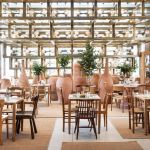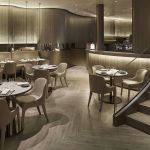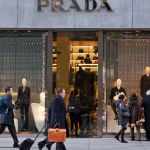During the past month, you might have heard that French designer Simon Jacquemus has opened the doors to a cafe in the Galeries Lafayette in Paris called Café Citron, which is very on theme with his brand’s aesthetic. A few months ago, Prada announced the opening of their first Marchesi 1824 bakery to be launched this spring in Mayfair, London and even designer Raf Simons recently partnered with Danish textile company Kvadarat for the opening of a temporary cafe during Milan’s Salone Del Mobile. So one might wonder, why is it that these fashion houses are now attempting to embark on these ventures inside the hospitality industry? Why are these people who dress us, now trying to also feed us?
The concept of designers broadening the customer experience with food and drink enhancements is nothing new.
Armani is one of the fashion houses that has been most successful in the hospitality industry. In 1998, they opened their first restaurant in Paris, and the brand has since opened over 20 franchises in Milan, Tokyo, Monaco and Dubai.
I’ve always wanted to create a complete Armani lifestyle that reflects my ideas and can be applied to different areas, not just fashion. Restaurant and cafés seemed a logical expansion. Giorgio Armani
Burberry also opened their London-based restaurant Thomas’s in 2015, named after the house’s founder. During that same year,
Ralph Lauren launched Ralph’s Coffee on Fifth Avenue in New York and
Gucci opened Gucci Café in Shangai. Today, customers can opt to eat at these and many more similar franchises including
Beige by Chanel, Vanitas at Palazzo
Versace, Ceresio 7 by
DSQUARED2, Rose Bakery by
Comme Des Garçons among many others.
Throughout the years, designers and fashion houses have witnessed the perks of breaking into the food and drink industries and have jumped towards the opportunity. Most times the aim is
to create an entire experience for their customer. An experience that makes the customer want to not only come in and eat but also shop. In most instances, the brands’ locations are strategically placed in the same buildings or nearby a store or outlet where one can purchase their clothes. It is all targeted at coaxing the customers to spend more time with the brand.
If you, as a retailer, can get your customers to spend more time with you, then, naturally, they will spend more as well - International Management Advisor Joseph Pine on BOF.
In achieving this more intimate relationship with the customer, the easiest and most profitable method has always been the food and drink industry. In the U.S., the food and beverage industry’s
projected sales for 2018 was $825 billion. In Asia, their 1.1 trillion dollars average annual intake is constantly on the rise thanks to their fast-growing rate of 10% per year and in 2017 Europe’s market
was recorded to have reached 508 billion. So it makes perfect sense as to why retailers would want to break into this market. It is, in fact, to be celebrated that the fashion industry is finally embracing its one time rival, the food and beverage industry and has found a chic middle ground on which to join forces, by creating these restaurants and cafés that are harmonious with each brand’s aesthetic. In a time where online shopping is so dominant it is important to find creative alternatives to get consumers up and out of the house, and of might, in fact, find that the quickest way to one’s pockets might actually be through their stomach.



























































